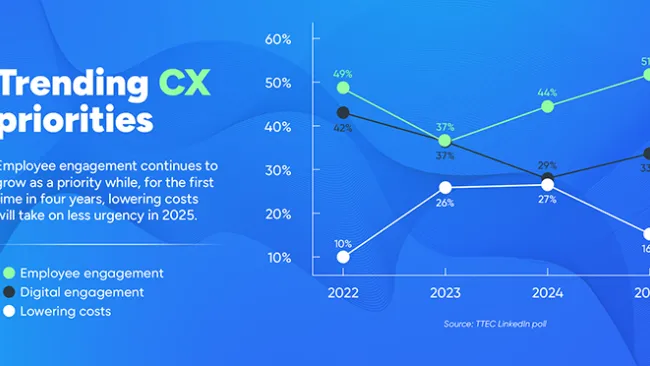An engaged workforce is a fundamental business driver for an organization’s success. And forward-thinking business leaders are striving to gain and retain high levels of employee engagement.
However, in a recent “State of the American Workforce” poll from Gallup, more than half of America’s workforce is disengaged. A large reason for that is the inability of companies to engage their employees who work remotely. Managing a team that's spread out in many locations can present huge challenges, even for the most experienced managers.
So, how does one build employee affinity and engagement when employees are working remotely or teammates are based in other locations?
Don Peppers said in the article, “A New Age for Human Capital,” within TeleTech’s e-book, “The Technology of Us,” that when a workforce is largely nomadic, the glue that culture provides can come apart. “The most important task for any business leader going forward is to cultivate, strengthen, and enliven company culture,” he said. “As work becomes increasingly dispersed in time and space, and as individual customers and employees become more connected and empowered by technology, it will become more vital — and, yet, more difficult — to engage employees with a socially developed, common sense of purpose.”
Don’t be a business that loses momentum by lack of employee drive. Use these tips to create a more engaged, productive, and empowered workforce.
1. Communicate
It’s all about communication. Communication is the cornerstone to trust and understanding. When employees at all levels are included in company discussions and given the reasoning behind a company decision, they are much more engaged. So why do some companies forgo communication and assume that team members know which direction to move toward? Regular communication is a must, especially if a goal is very specific. Some easy ways to improve communication are to set up internal activity feeds, arrange reoccurring team updates and reports, and instate goal notifications.
2. Invest in Continuous Training
Continuous training goes a long way and benefits not just the employee, but also the company. It helps employees expand their knowledge and abilities and is an important driver of engagement. Failure to provide this may leave employees feeling uncertain about their potential to grow within the company. Mentoring and coaching employees is extremely important. It’s how they can figure out what they are doing right or wrong as they are working on their objectives. More importantly, it’s how you can keep their attention. When you regularly give your employees advice on everything from their goals to their career aspirations, you effectively show that you care about their professional futures. And, when you care, the feeling will likely be reciprocated.
3. Tie Employee Promotions to Customer Metrics
Align career advancement opportunities to customer-focused metrics like customer satisfaction. For example, managers can be eligible for promotions when they've achieved specific customer satisfaction objectives. Whatever your employee engagement strategies include, it's important to remember that high levels of employee engagement in an organization are linked to superior business performance. What's your strategy for getting there?
4. Set up Employee Listening Posts
Listening to employee voice is crucial for getting employee engagement right. Sam Stern, senior analyst at Forrester Research, said in his blog that an effective voice of the employee program aims to collect feedback from employees systematically. He says that CX teams have to cast a wide net to collect different elements of VoE data, from insights about a customer’s pain points to the underlying policies, processes, and technology systems affecting the customer’s—and the employee’s—own experience. Customer experience leader Zappos, for instance, describes in this article how management listens to feedback in a variety of ways from surveys to regular team lunches where they discuss issues and how to improve upon things.
Employee engagement is more than a buzz word. Disengaged employees can negatively affect customer service, impact employee retention, and drive down profits. According to Peppers, sustaining an engaged workforce requires a new breed of business leader—one whose first task each morning is to think hard about the company’s mission, adapt it as needed, and communicate it to a continuously evolving workforce.
Click here to read the full article, “A New Age for Human Capital.”
Also, check out the most recent issue of our e-newsletter.
Four Tips to Engage and Empower Your Workforce















